On the Large Variation in Atmospheric CO2 Concentration at Shangdianzi GAW Station during Two Dust Storm Events in March 2021
Abstract
:1. Introduction
2. Materials and Methods
2.1. Observational Site and Data
2.2. WRF-VPRM Simulation
3. Results
3.1. Two Dust Storms over Northern China in March 2021
3.2. Impact of Dust Storm Events on the Variation of CO2 Concentration
3.2.1. Variations of Surface Meteorological Conditions
3.2.2. Evaluation of the WRF-VPRM Simulation
3.2.3. Impact on Biogenic CO2 Contribution
3.2.4. Impact on Regional Transport of Atmospheric CO2
4. Conclusions
Author Contributions
Funding
Institutional Review Board Statement
Informed Consent Statement
Data Availability Statement
Conflicts of Interest
Abbreviations
| Symbols | Full Name | Symbols | Full Name |
| WS | wind speed | PAR | photosynthetically active radiation |
| WD | wind direction | PAR0 | half-saturation value of PAR |
| Ta | air temperature | FAPARPAV | the fraction of PAR absorbed by the photosynthetically active portion of the vegetation |
| RH | relative humidity | EVI | enhanced vegetation index |
| Pa | air pressure | GSWI | global shortwave irradiance |
| Vis | atmospheric visibility | DSWI | direct shortwave irradiance |
| q | specific humidity | DifSWI | diffuse shortwave irradiance |
| NEE | net ecosystem exchange | DnLWI | downward longwave irradiance |
| GEE | gross ecosystem exchange | w’ | fluctuation for vertical velocity |
| ER | ecosystem respiration | c’ | fluctuation in CO2 concentration |
| λ | the maximum light use efficiency | R | correlation coefficient |
| Tscale | temperature scale | UT | Universal Time |
| Wscale | water stress scale | BT | Beijing Time |
| Pscale | phenology scale | SDZ | Shangdianzi station |
References
- Shao, Y. Physics and Modelling of Wind Erosion; Springer: Dordrecht, The Netherlands, 2008. [Google Scholar]
- Zhang, X.Y.; Gong, S.L.; Shen, Z.X.; Mei, F.M.; Xi, X.X.; Liu, L.C.; Zhou, Z.J.; Wang, D.; Wang, Y.Q.; Cheng, Y. Characterization of soil dust aerosol in China and its transport and distribution during 2001 ACE-Asia: 1. Network observations. J. Geophys. Res.-Atmos. 2003, 108, 1–13. [Google Scholar] [CrossRef]
- Yu, H.; Tan, Q.; Zhou, L.; Zhou, Y.; Bian, H.; Chin, M.; Ryder, C.L.; Levy, R.C.; Pradhan, Y.; Shi, Y.; et al. Observation and modeling of the historic “Godzilla” African dust intrusion into the Caribbean Basin and the southern US in June 2020. Atmos. Chem. Phys. 2021, 21, 12359–12383. [Google Scholar] [CrossRef]
- Griffin, D.W.; Kellogg, C.A. Dust storms and their impact on ocean and human health: Dust in Earth’s atmosphere. EcoHealth 2004, 1, 284–295. [Google Scholar] [CrossRef]
- Hashizume, M.; Ueda, K.; Nishiwaki, Y.; Michikawa, T.; Onozuka, D. Health effects of Asian dust events: A review of the literature. Jpn. J. Hyg. 2010, 65, 413–421. [Google Scholar] [CrossRef] [PubMed]
- Kok, J.F.; Adebiyi, A.A.; Albani, S.; Balkanski, Y.; Checa-Garcia, R.; Chin, M.; Colarco, P.R.; Hamilton, D.S.; Huang, Y.; Ito, A.; et al. Contribution of the world’s main dust source regions to the global cycle of desert dust. Atmos. Chem. Phys. 2021, 21, 8169–8193. [Google Scholar] [CrossRef]
- Huang, X.X.; Wang, T.J.; Jiang, F.; Liao, J.B.; Cai, Y.F.; Yin, C.Q.; Zhu, J.L.; Han, Y. Studies on a severe dust storm in East Asia and its impact on the air quality of Nanjing, China. Aerosol Air Qual. Res. 2013, 13, 179–193. [Google Scholar] [CrossRef]
- Liu, X.; Wang, J.; Qiu, J.; Li, Q.; Dong, J.; Wei, L. Influence of dust storms on air pollution for replacement and addition in Lanzhou. China Environ. Sci. 2018, 38, 1646–1652, (In Chinese with English abstract). [Google Scholar]
- Li, J.; Hao, X.; Liao, H.; Yue, X.; Li, H.; Long, X.; Li, N. Predominant type of dust storms that influence air quality over northern China and future projections. Earth’s Future 2022, 10, e2022EF002649. [Google Scholar] [CrossRef]
- Filonchyk, M. Characteristics of the severe March 2021 Gobi Desert dust storm and its impact on air pollution in China. Chemosphere 2022, 287, 132219. [Google Scholar] [CrossRef]
- Nan, Y.; Wang, Y. Observational evidence for direct uptake of ozone in China by Asian dust in springtime. Atmos. Environ. 2018, 186, 45–55. [Google Scholar] [CrossRef]
- Hu, X.-M.; Hu, J.; Gao, L.; Cai, C.; Jiang, Y.; Xue, M.; Zhao, T.; Crowell, S.M. Multisensor and multimodel monitoring and investigation of a wintertime air pollution event ahead of a cold front over eastern China. J. Geophys. Res. Atmos. 2021, 126, e2020JD033538. [Google Scholar] [CrossRef]
- Chan, D.; Yuen, C.W.; Higuchi, K.; Shashkov, A.; Liu, J.; Chen, J.; Worthy, D. On the CO2 exchange between the atmosphere and the biosphere: The role of synoptic and mesoscale processes. Tellus B Chem. Phys. Meteorol. 2004, 56, 194–212. [Google Scholar] [CrossRef]
- Hu, X.-M.; Gourdji, S.M.; Davis, K.J.; Wang, Q.; Zhang, Y.; Xue, M.; Feng, S.; Moore, B.; Crowell, S.M. Implementation of improved parameterization of terrestrial flux in WRF-VPRM improves the simulation of nighttime CO2 peaks and a daytime CO2 band ahead of a cold front. J. Geophys. Res. Atmos. 2021, 126, e2020JD034362. [Google Scholar] [CrossRef]
- Ahmadov, R.; Gerbig, C.; Kretschmer, R.; Koerner, S.; Neininger, B.; Dolman, A.J.; Sarrat, C. Mesoscale covariance of transport and CO2 fluxes: Evidence from observations and simulations using the WRF-VPRM coupled atmosphere-biosphere model. J. Geophys. Res. 2007, 112, D22107. [Google Scholar] [CrossRef]
- Li, X.; Hu, X.-M.; Cai, C.; Jia, Q.; Zhang, Y.; Liu, J.; Xue, M.; Xu, J.; Wen, R.; Crowell, S.M. Terrestrial CO2 fluxes, concentrations, sources and budget in Northeast China: Observational and modeling studies. J. Geophys. Res. Atmos. 2020, 125, e2019JD031686. [Google Scholar] [CrossRef]
- Cheng, Y.; Aa, X.; Yun, F.; Zhou, L.; Liu, L.; Fang, S.; Xu, L. Simulation of CO2 variations at Chinese background atmospheric monitoring stations between 2000 and 2009: Applying a CarbonTracker model. Chin. Sci. Bull. 2013, 58, 3986–3993. [Google Scholar] [CrossRef]
- Feng, S.; Lauvaux, T.; Newman, S.; Rao, P.; Ahmadov, R.; Deng, A.; Díaz-Isaac, L.I.; Duren, R.M.; Fischer, M.L.; Gerbig, C.; et al. Los Angeles megacity: A high-resolution land-atmosphere modelling system for urban CO2 emissions. Atmos. Chem. Phys. 2016, 16, 9019–9045. [Google Scholar] [CrossRef]
- Park, C.; Gerbig, C.; Newman, S.; Ahmadov, R.; Feng, S.; Gurney, K.R.; Carmichael, G.R.; Park, S.-Y.; Lee, H.-W.; Goulden, M.; et al. CO2 transport, variability, and budget over the Southern California Air Basin using the high-resolution WRF-VPRM model during the CalNex 2010 campaign. J. Appl. Meteorol. Clim. 2018, 57, 1337–1352. [Google Scholar] [CrossRef]
- Pillai, D.; Gerbig, C.; Ahmadov, R.; Rödenbeck, C.; Kretschmer, R.; Koch, T.; Thompson, R.; Neininger, B.; Lavrié, J.V. High-resolution simulations of atmospheric CO2 over complex terrain–representing the Ochsenkopf mountain tall tower. Atmos. Chem. Phys. 2011, 11, 7445–7464. [Google Scholar] [CrossRef]
- Diao, Y.; Huang, J.; Liu, C.; Cui, J.; Liu, S. A modeling study of CO2 flux and concentrations over the Yangtze River Delta using the WRF-GHG model. Chin. J. Atmos. Sci. 2015, 39, 849–860, (In Chinese with English abstract). [Google Scholar]
- Guo, M.; Wang, X.; Liu, Y.; Li, J.; Wang, H.; Matsuoka, N.; Tani, H. The effects of sand dust storms on greenhouse gases. Int. J. Remote Sens. 2012, 33, 6838–6853. [Google Scholar] [CrossRef]
- Zhou, H.G.; Quan, W.J.; Wang, Z.F.; Li, X.L.; Li, Y.R.; Zhao, H.J. Comparison of sunshine duration measurements between a Jordan sunshine recorder and three automatic sensors at Shangdianzi GAW station. J. Meteorol. Res. 2021, 35, 716–728. [Google Scholar] [CrossRef]
- An, X.; Zhou, L.; Yao, B.; Xu, L.; Ma, L. Analysis on source features of halogenated gases at Shangdianzi regional atmospheric background station. Atmos. Environ. 2012, 57, 91–100. [Google Scholar] [CrossRef]
- Ali, A.S.; Zanzinger, Z.; Debose, D.; Stephens, B. Open Source Building Science Sensors (OSBSS): A low-cost Arduino-based platform for long-term indoor environmental data collection. Build. Environ. 2016, 100, 114–126. [Google Scholar] [CrossRef]
- Martin, C.R.; Zeng, N.; Karion, A.; Dickerson, R.R.; Ren, X.; Turpie, B.N.; Weber, K.J. Evaluation and environmental correction of ambient CO2 measurements from a low-cost NDIR sensor. Atmos. Meas. Tech. 2017, 10, 2383–2395. [Google Scholar] [CrossRef] [PubMed]
- Sense Air. K30 Products Sheets. 2019. Available online: https://senseair.com/products/flexibility-counts/k30/ (accessed on 20 July 2020).
- Khan, A.; Schaefer, D.; Tao, L.; Miller, D.J.; Sun, K.; Zondlo, M.A.; Harrison, W.A.; Roscoe, B.; Lary, D.J. Low Power Greenhouse Gas Sensors for Unmanned Aerial Vehicles. Remote Sens. 2012, 4, 1355–1368. [Google Scholar] [CrossRef]
- Shusterman, A.A.; Teige, V.E.; Turner, A.J.; Newman, C.; Kim, J.; Cohen, R.C. The BErkeley Atmospheric CO2 Observation Network: Initial evaluation. Atmos. Chem. Phys. 2016, 16, 13449–13463. [Google Scholar] [CrossRef]
- Müller, M.; Graf, P.; Meyer, J.; Pentina, A.; Brunner, D.; Perez-Cruz, F.; Hüglin, C.; Emmenegger, L. Integration and calibration of non-dispersive infrared (NDIR) CO2 low-cost sensors and their operation in a sensor network covering Switzerland. Atmos. Meas. Tech. 2020, 13, 3815–3834. [Google Scholar] [CrossRef]
- Bao, Z.; Han, P.; Zeng, N.; Liu, D.; Cai, Q.; Wang, Y.; Tang, G.; Zheng, K.; Yao, B. Observation and modeling of vertical carbon dioxide distribution in a heavily polluted suburban environment. Atmos. Ocean. Sci. Lett. 2020, 13, 371–379. [Google Scholar] [CrossRef]
- Liu, D.; Sun, W.; Zeng, N.; Han, P.; Yao, B.; Liu, Z.; Wang, P.; Zheng, K.; Mei, H.; Cai, Q. Observed decreases in on-road CO2 concentrations in Beijing during COVID-19 restrictions. Atmos. Chem. Phys. 2021, 21, 4599–4614. [Google Scholar] [CrossRef]
- Mauder, M.; Foken, T.; Clement, R.; Elbers, J.A.; Eugster, W.; Grünwald, T.; Heusinkveld, B.; Kolle, O. Quality control of CarboEurope flux data? Part 2: Inter-comparison of eddy-covariance software. Biogeosciences 2008, 5, 451–462. [Google Scholar] [CrossRef]
- Hua, H.X.; Zhang, R.Q.; Li, Z.H.; Tian, X. Installation, application and maintenance of HY-WP1 intelligent weather observation instrument. Henan Sci. Tech. 2021, 31, 6–8, (In Chinese with English abstract). [Google Scholar]
- Li, X.; Zhang, H. Seasonal variations in dust concentration and dust emission observed over Horqin Sandy Land area in China from December 2010 to November 2011. Atmos. Environ. 2012, 61, 56–65. [Google Scholar] [CrossRef]
- Tian, P.; Zhang, L.; Ma, J.; Tang, K.; Xu, L.; Wang, Y.; Cao, X.; Liang, J.; Ji, Y.; Jiang, J.H.; et al. Radiative absorption enhancement of dust mixed with anthropogenic pollution over East Asia. Atmos. Chem. Phys. 2018, 18, 7815–7825. [Google Scholar] [CrossRef]
- Fan, H.; Zhao, C.; Yang, Y.; Yang, X. Spatio-temporal variations of the PM2.5/PM10 ratios and its application to air pollution type classification in China. Front. Environ. Sci. 2021, 9, 692440. [Google Scholar] [CrossRef]
- Mahadevan, P.; Wofsy, S.C.; Matross, D.M.; Xiao, X.; Dunn, A.L.; Lin, J.C.; Gerbig, C.; Munger, J.W.; Chow, V.Y.; Gottlieb, E.W. A satellite-based biosphere parameterization for net ecosystem CO2 exchange: Vegetation Photosynthesis and Respiration Model (VPRM). Glob. Biogeochem. Cycles 2008, 22, GB2005. [Google Scholar] [CrossRef]
- Gourdji, S.M.; Karion, A.; Lopez-Coto, I.; Ghosh, S.; Mueller, K.L.; Zhou, Y.; Williams, C.A.; Baker, I.T.; Haynes, K.D.; Whetstone, J.R. A modified Vegetation Photosynthesis and Respiration Model (VPRM) for the eastern USA and Canada, evaluated with comparison to atmospheric observations and other biospheric models. J. Geophys. Res. Biogeo. 2022, 127, e2021JG006290. [Google Scholar] [CrossRef]
- Hu, X.-M.; Xue, M.; McPherson, R.A. The importance of soil-type contrast in modulating August precipitation distribution near the Edwards Plateau and Balcones Escarpment in Texas. J. Geophys. Res. 2017, 122, 10711–10728. [Google Scholar] [CrossRef]
- Hu, X.-M.; Xue, M.; McPherson, R.A.; Martin, E.; Rosendahl, D.H.; Qiao, L. Precipitation dynamical downscaling over the Great Plains. J. Adv. Model. Earth Syst. 2018, 10, 421–447. [Google Scholar] [CrossRef]
- Hu, X.-M.; Crowell, S.; Wang, Q.; Zhang, Y.; Davis, K.J.; Xue, M.; Xiao, X.; Moore, B.; Wu, X.; Choi, Y.; et al. Dynamical Downscaling of CO2 in 2016 over the contiguous United States using WRF-VPRM, a weather-biosphere-online-coupled model. J. Adv. Model. Earth Syst. 2020, 12, e2019MS001875. [Google Scholar] [CrossRef]
- Takahashi, T.; Sutherland, S.C.; Wanninkhof, R.; Sweeney, C.; Feely, R.A.; Chipman, D.W.; Hales, B.; Friederich, G.; Chavez, F.; Sabine, C.; et al. Climatological mean and decadal change in surface ocean pCO2, and net sea-air CO2 flux over the global oceans. Deep-Sea Res. Part II Top. Stud. Oceanogr. 2009, 56, 554–577. [Google Scholar] [CrossRef]
- Jin, J.; Pang, M.; Segers, A.; Han, W.; Fang, L.; Li, B.; Feng, H.; Lin, H.; Liao, H. Inverse modeling of the 2021 spring super dust storms in East Asia. Atmos. Chem. Phys. 2022, 22, 6393–6410. [Google Scholar] [CrossRef]
- Gui, K.; Yao, W.; Che, H.; An, L.; Zheng, Y.; Li, L.; Zhang, X. Record-breaking dust loading during two mega dust storm events over northern China in March 2021: Aerosol optical and radiative properties and meteorological drivers. Atmos. Chem. Phys. 2022, 22, 7905–7932. [Google Scholar] [CrossRef]
- Liang, P.; Chen, B.; Yang, X.; Liu, Q.; Li, A.; Mackenzie, L.; Zhang, D. Revealing the dust transport processes of the 2021 mega dust storm event in northern China. Sci. Bull. 2021, 67, 21–24. [Google Scholar] [CrossRef]
- Filonchyk, M.; Peterson, M. Development, progression, and impact on urban air quality of the dust storm in Asia in March 15–18, 2021. Urban Clim. 2022, 41, 101080. [Google Scholar] [CrossRef]
- Hu, X.-M.; Klein, P.M.; Xue, M.; Shapiro, A.; Nallapareddy, A. Enhanced vertical mixing associated with a nocturnal cold front passage and its impact on near-surface temperature and ozone concentration. J. Geophys. Res. Atmos. 2013, 118, 2714–2728. [Google Scholar] [CrossRef]
- Jiang, Y.; Wang, Q.; Zhang, H.; Wang, Z.; Hu, B. Radiation characteristics of urban boundary layer measured on the meteorological tower in Beijing. Plateau Meteorol. 2010, 29, 918–928, (In Chinese with English abstract). [Google Scholar]
- Li, X.; Ma, Y.; Wang, Y.; Lu, S.; Zhao, H.; Liu, N.; Wang, D. Characteristics of turbulence and aerosol optical and radiative properties during haze–fog episodes in Shenyang, Northeast China. Atmosphere 2021, 12, 1658. [Google Scholar] [CrossRef]
- Halthore, R.N.; Schwartz, S.E. Comparison of model-estimated and measured diffuse downward irradiance at surface in cloud-free skies. J. Geophys. Res. Atmos. 2000, 105, 20165–20177. [Google Scholar] [CrossRef]
- Zhang, J.R.; Wang, Y.W.; Zhang, M.; Diao, Y.W.; Liu, C. Optimization and validation of the vegetation photosynthesis and respiration model in a temperate broad-leaved Korean pine forest. Acta Ecol. Sin. 2017, 37, 6679–6690, (In Chinese with English abstract). [Google Scholar]
- Dayalu, A.; Munger, J.W.; Wofsy, S.C.; Wang, Y.; Nehrkorn, T.; Zhao, Y.; McElroy, M.B.; Nielsen, C.P.; Luus, K. Assessing biotic contributions to CO2 fluxes in northern China using the Vegetation, Photosynthesis and Respiration Model (VPRM-CHINA) and observations from 2005 to 2009. Biogeosciences 2018, 15, 6713–6729. [Google Scholar] [CrossRef]
- Xie, X.; Wang, T.; Yue, X.; Li, S.; Zhuang, B.; Wang, M. Effect of atmospheric aerosols on terrestrial carbon fluxes and CO2 concentrations in China. Atmos. Res. 2020, 237, 1. [Google Scholar] [CrossRef]
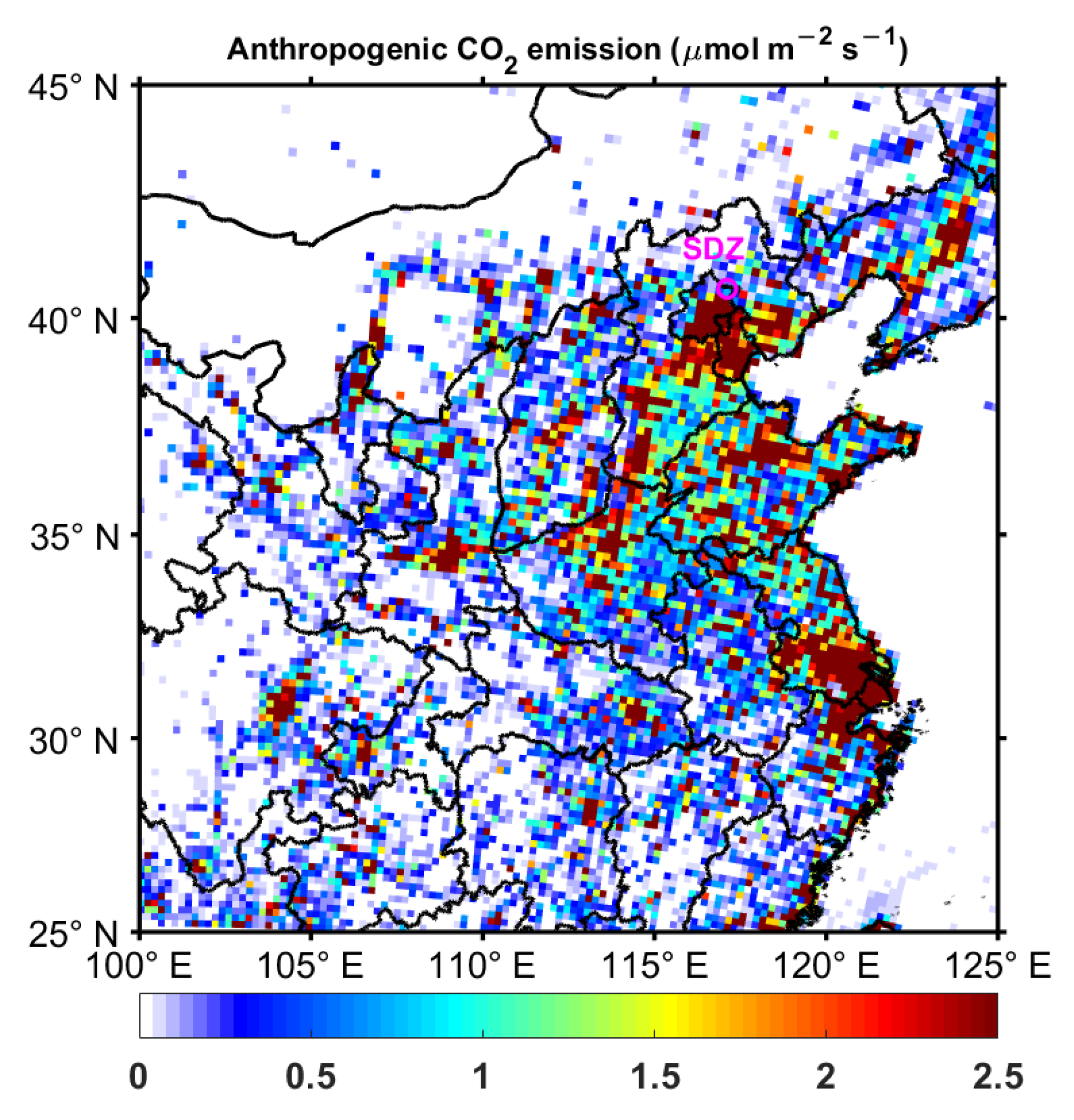
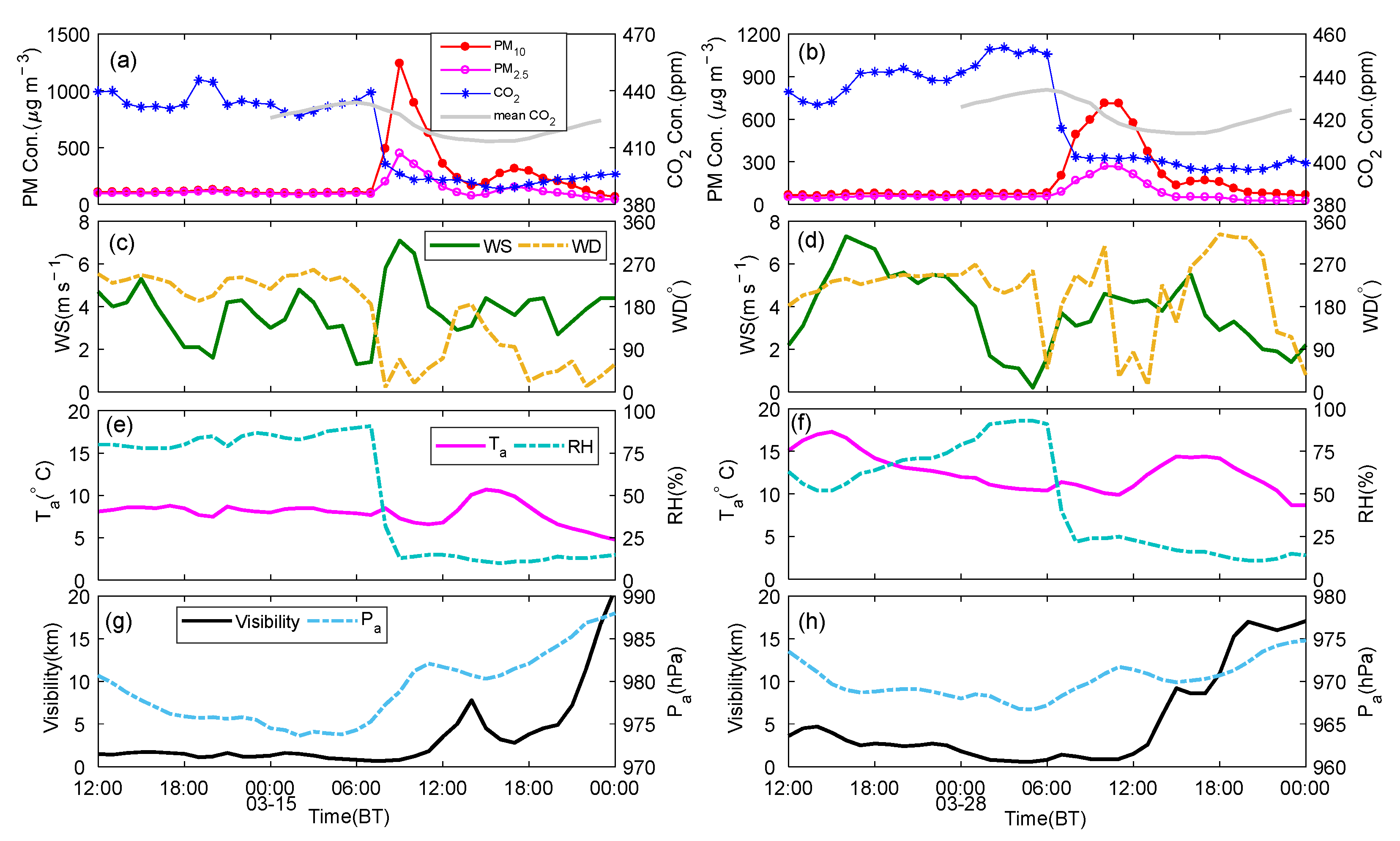

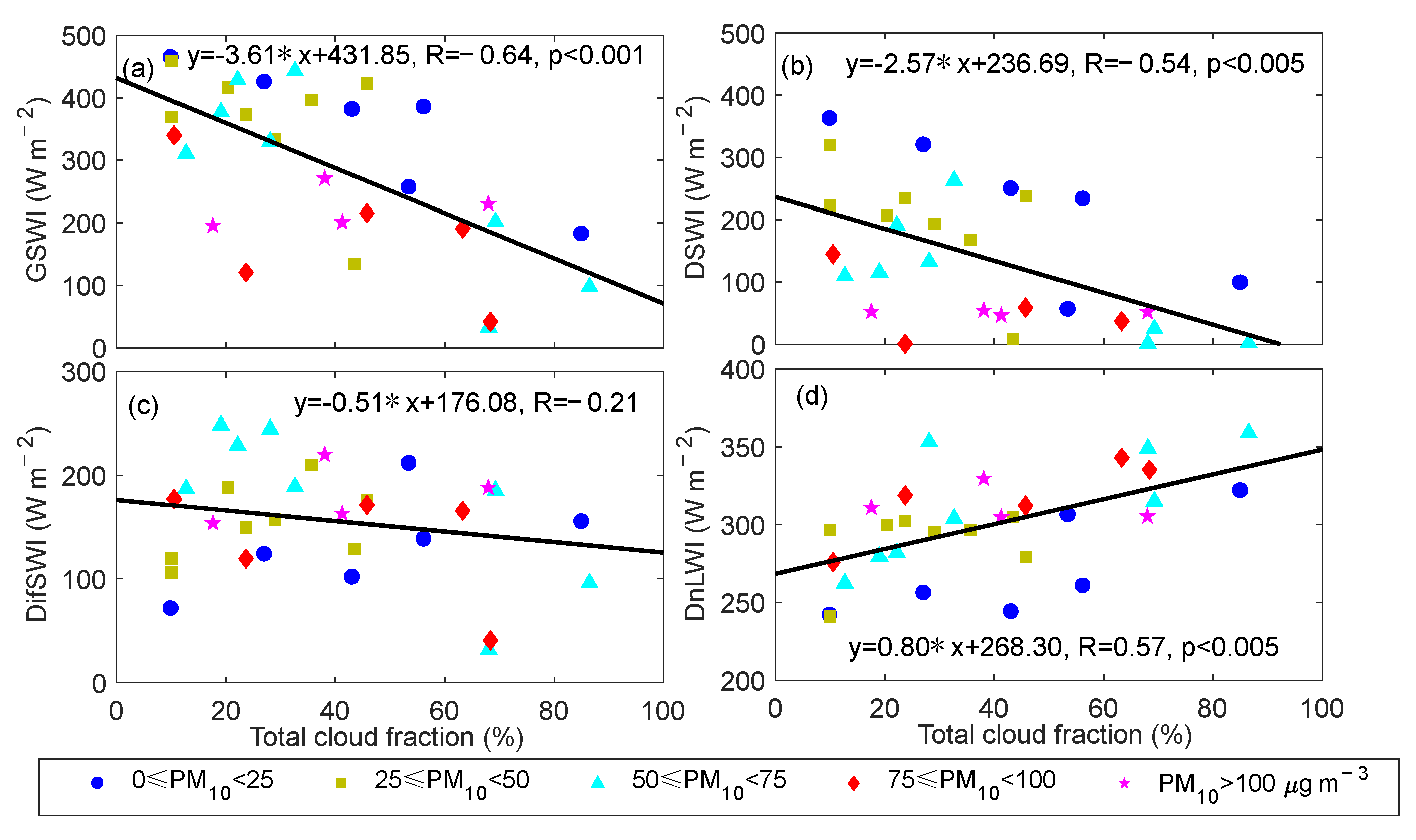
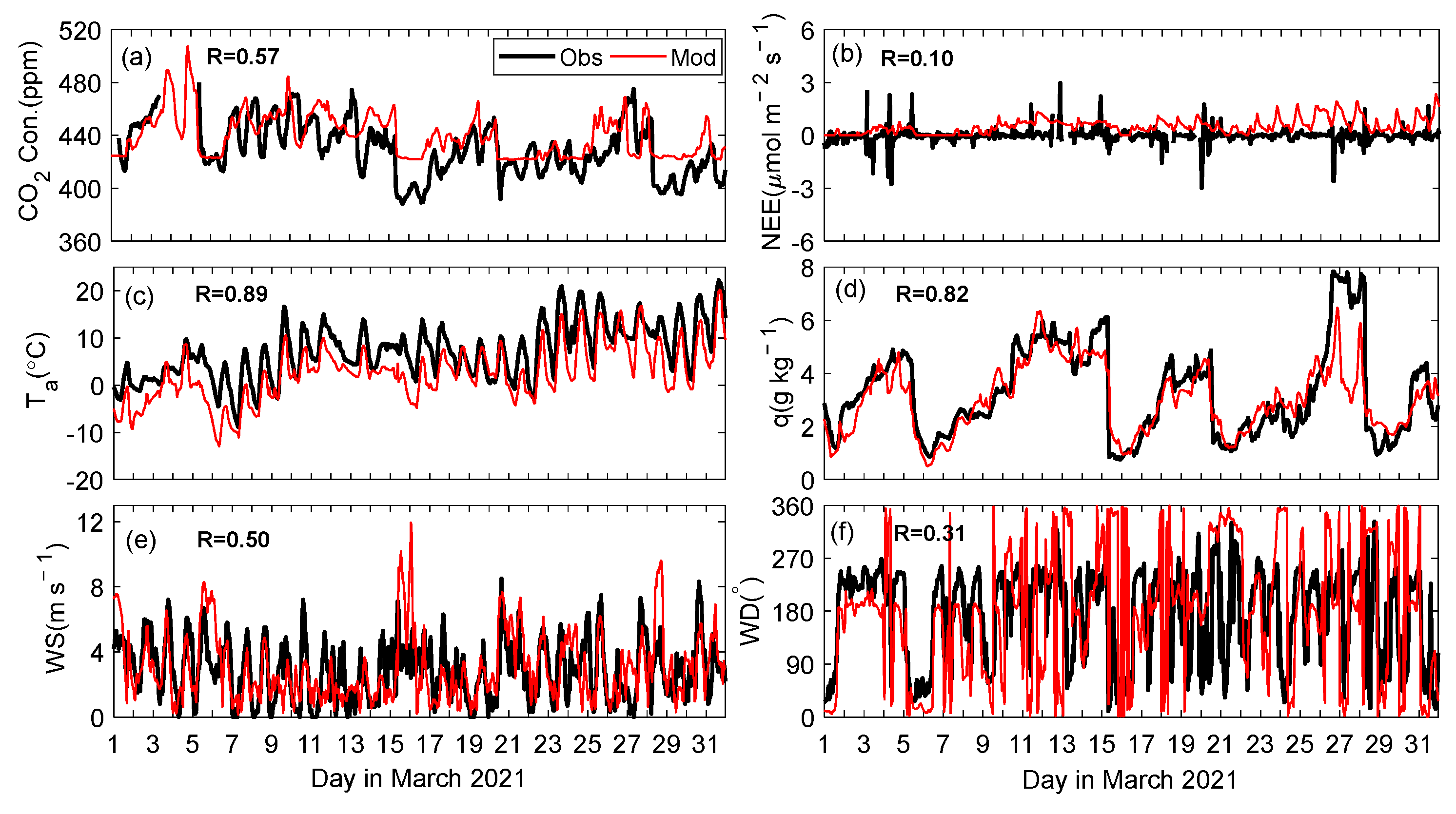

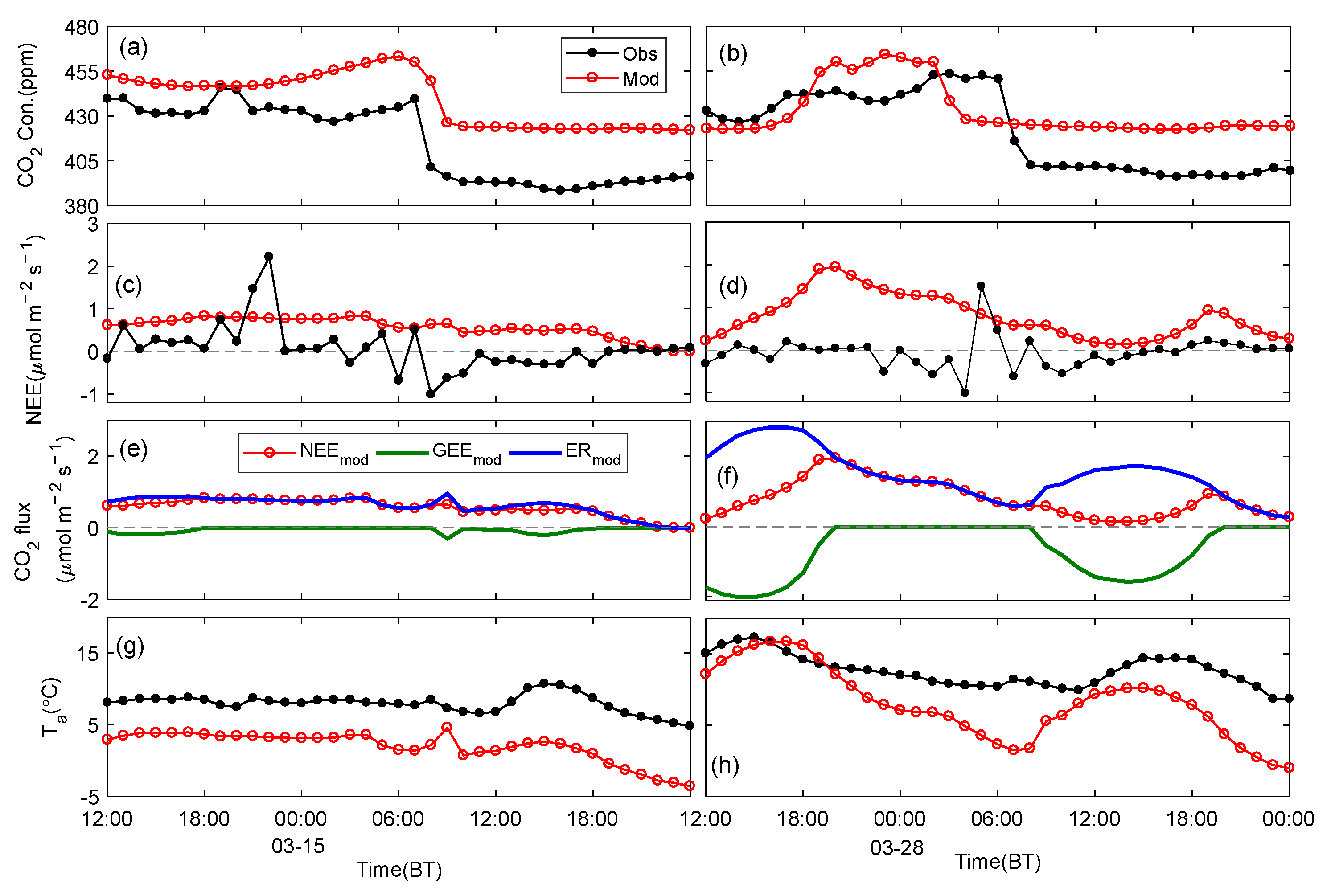
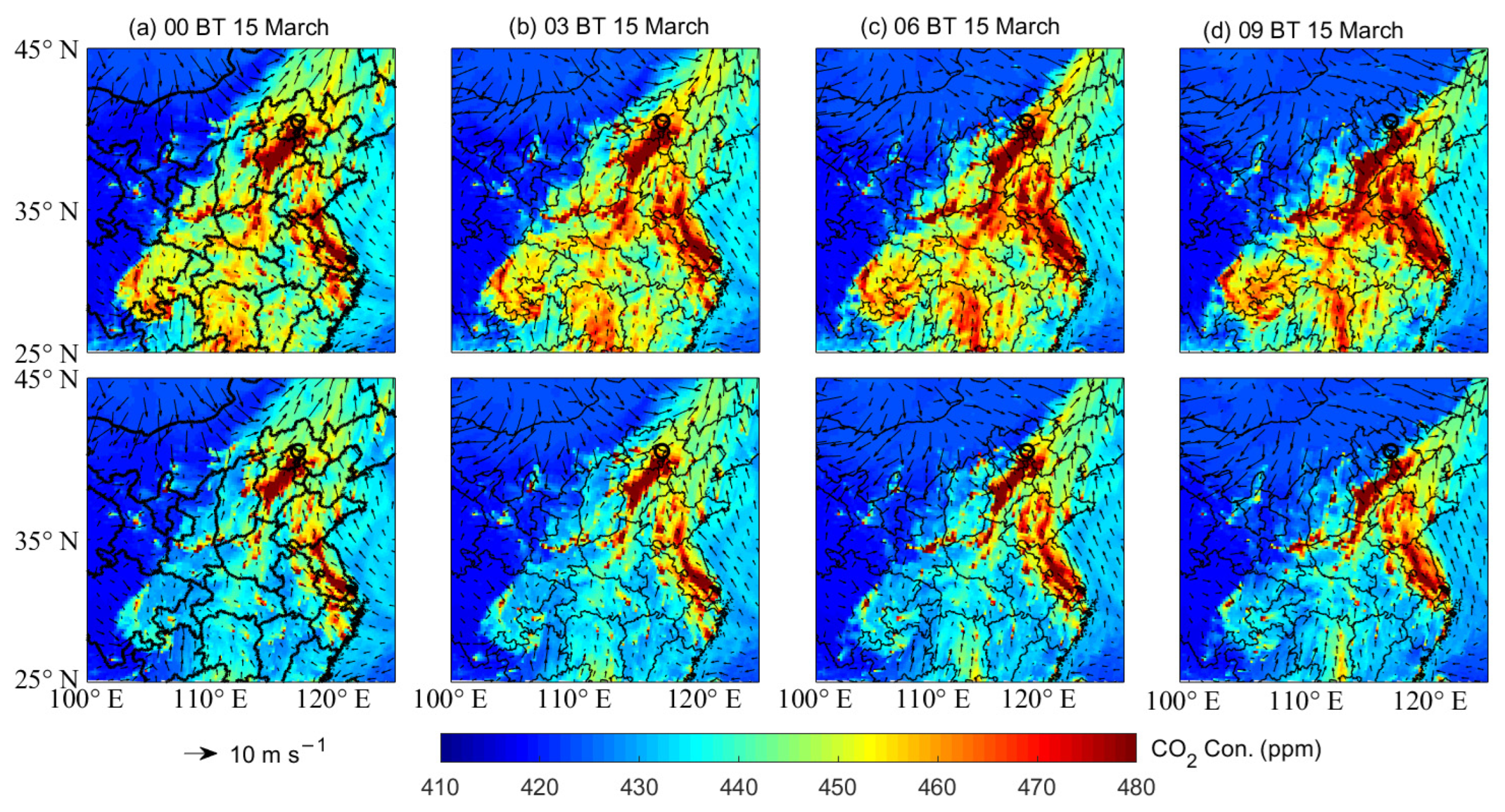
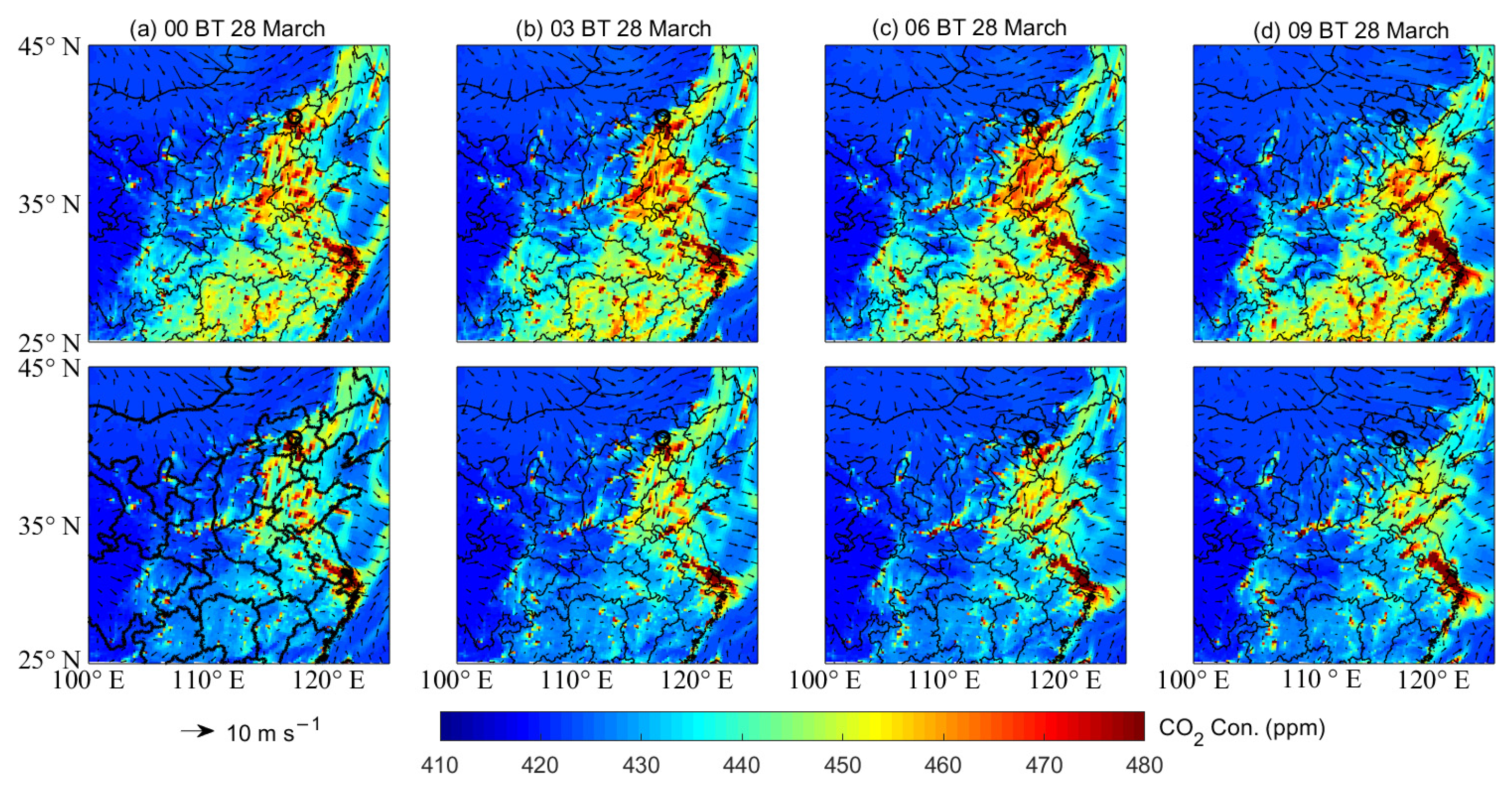
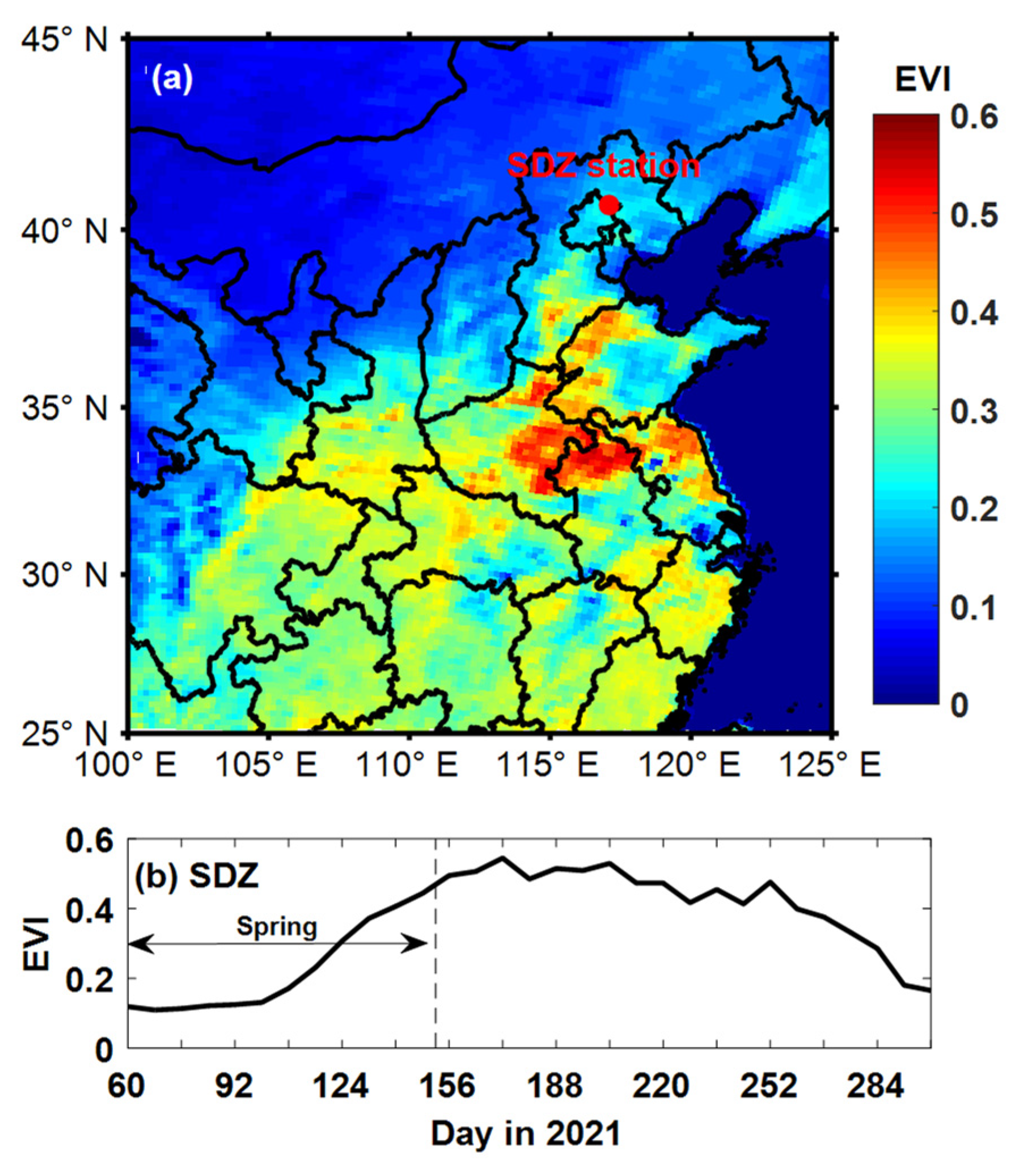
| Variable | Interval | Height (AGL) | Device | Accuracy |
|---|---|---|---|---|
| CO2 concentration | 1 h | 1.5 m above the top of the SDZ building | K30; IAP, Beijing, China | ±5 ppm |
| Fluctuation of CO2 concentration | 10 Hz | 63 m | LI-7500; Li-Cor, Lincoln, NE, USA | ±1% of the record |
| Fluctuation of WS and Ta | 10 Hz | 63 m | CSAT3; Campbell, Logan, UT, USA | WS: ±0.01 m s−1 Ta: ±0.01 °C |
| Fluctuation of WS and Ta | 10 Hz | 63 m | CSAT3; Campbell, Logan, UT, USA | WS: ±0.01 m s−1 Ta: ±0.01 °C |
| WS, WD, Ta, RH, and Pa | 5 min | 10 m (WS and WD) 1.5 m (others) above the ground | DZZ5 automatic weather station; Huayun, Beijing, China | WS: 0.1 m s−1, WD: 3°, Ta: 0.1 °C, RH: 1%, Pa: 0.1 hPa |
| Visibility | 5 min | 2.5 m above the ground | FD12; Väsälä, Vantaa, Finland | ±10%, 10 m–10 km ±20%, 10–50 km |
| Global shortwave irradiance Diffuse shortwave irradiance 1 | 1 min | 1.5 m above the top of the SDZ building | CMP11 pyranometer; Kipp and Zonen, Delft, South Holland, The Netherlands | <2 W m−2 |
| Direct shortwave irradiance 1 | 1 min | 1.5 m above the top of the SDZ building | CHP1 pyrheliometer; Kipp and Zonen, Delft, South Holland, The Netherlands | ±1 W m−2 |
| Downward longwave irradiance 1 | 1 min | 1.5 m above the top of the SDZ building | IR02 pyrgeometer; Hukseflux, Delft, South Holland, The Netherlands | Temperature dependence: <±3% |
| Total cloud fraction | 1 min | 1.5 m above the top of the SDZ building | HY-WP1A; Huayun, Beijing, China | <±10% |
| PM10 and PM2.5 concentration | 1 min | 1.5 m above the top of the SDZ building | TEOM 1400a; Thermo Electron Corporation, Waltham, MA, USA | ±1.50 μg m−3 |
| Source | Dataset | Variable | Resolution | Purpose |
|---|---|---|---|---|
| MODIS data | MOD09A1 C6 | Land surface water index (LSWI) and EVI | 500 m, 8 days | Calculating Wscale, GEE, and ER |
| MCD12Q1 C51 | Fraction of land surface vegetation | 500 m | Calculating Tscale and GEE | |
| DOE R2 | Meteorological data | 20 km | Providing the meteorological initial and boundary conditions | |
| Copernicus Atmosphere Monitoring Service (CAMS) reanalysis | CAMS | CO2 | 1.9° × 3.75° | Providing atmospheric CO2 initial and boundary conditions |
| ODIAC | Anthropogenic source | CO2 flux | 0.1° × 0.1° | Providing the monthly anthropogenic emissions of CO2 |
| Takahashi et al. [37] | Oceanic source/sink | CO2 flux | 4° × 5°, monthly mean | Providing the CO2 exchange between the ocean and the atmosphere |
| Event | Time | WS (m s−1) | WD (°) | Ta (°C) | RH (%) | Pa (hPa) | Vis (km) | PM10 (µg m−3) | CO2 (ppm) |
|---|---|---|---|---|---|---|---|---|---|
| Dust storm on 15 March | 07:00 BT | 1.3 | SW | 7.9 | 90 | 974.3 | 0.8 | 103.9 | 439.3 |
| 09:00 BT | 7.1 | ENE | 7.3 | 13 | 978.8 | 0.8 | 1240.6 | 396.1 | |
| Dust storm on 28 March | 06:00 BT | 1.6 | NE | 10.4 | 91 | 967.2 | 0.8 | 79.4 | 450.6 |
| 10:00 BT | 4.6 | NW | 10.1 | 24 | 970.9 | 0.9 | 712.4 | 402.4 |
Disclaimer/Publisher’s Note: The statements, opinions and data contained in all publications are solely those of the individual author(s) and contributor(s) and not of MDPI and/or the editor(s). MDPI and/or the editor(s) disclaim responsibility for any injury to people or property resulting from any ideas, methods, instructions or products referred to in the content. |
© 2023 by the authors. Licensee MDPI, Basel, Switzerland. This article is an open access article distributed under the terms and conditions of the Creative Commons Attribution (CC BY) license (https://creativecommons.org/licenses/by/4.0/).
Share and Cite
Li, X.; Quan, W.; Hu, X.-M.; Jia, Q.; Ma, Z.; Dong, F.; Zhang, Y.; Zhou, H.; Wang, D. On the Large Variation in Atmospheric CO2 Concentration at Shangdianzi GAW Station during Two Dust Storm Events in March 2021. Atmosphere 2023, 14, 1348. https://doi.org/10.3390/atmos14091348
Li X, Quan W, Hu X-M, Jia Q, Ma Z, Dong F, Zhang Y, Zhou H, Wang D. On the Large Variation in Atmospheric CO2 Concentration at Shangdianzi GAW Station during Two Dust Storm Events in March 2021. Atmosphere. 2023; 14(9):1348. https://doi.org/10.3390/atmos14091348
Chicago/Turabian StyleLi, Xiaolan, Weijun Quan, Xiao-Ming Hu, Qingyu Jia, Zhiqiang Ma, Fan Dong, Yimeng Zhang, Huaigang Zhou, and Dongdong Wang. 2023. "On the Large Variation in Atmospheric CO2 Concentration at Shangdianzi GAW Station during Two Dust Storm Events in March 2021" Atmosphere 14, no. 9: 1348. https://doi.org/10.3390/atmos14091348
APA StyleLi, X., Quan, W., Hu, X. -M., Jia, Q., Ma, Z., Dong, F., Zhang, Y., Zhou, H., & Wang, D. (2023). On the Large Variation in Atmospheric CO2 Concentration at Shangdianzi GAW Station during Two Dust Storm Events in March 2021. Atmosphere, 14(9), 1348. https://doi.org/10.3390/atmos14091348









